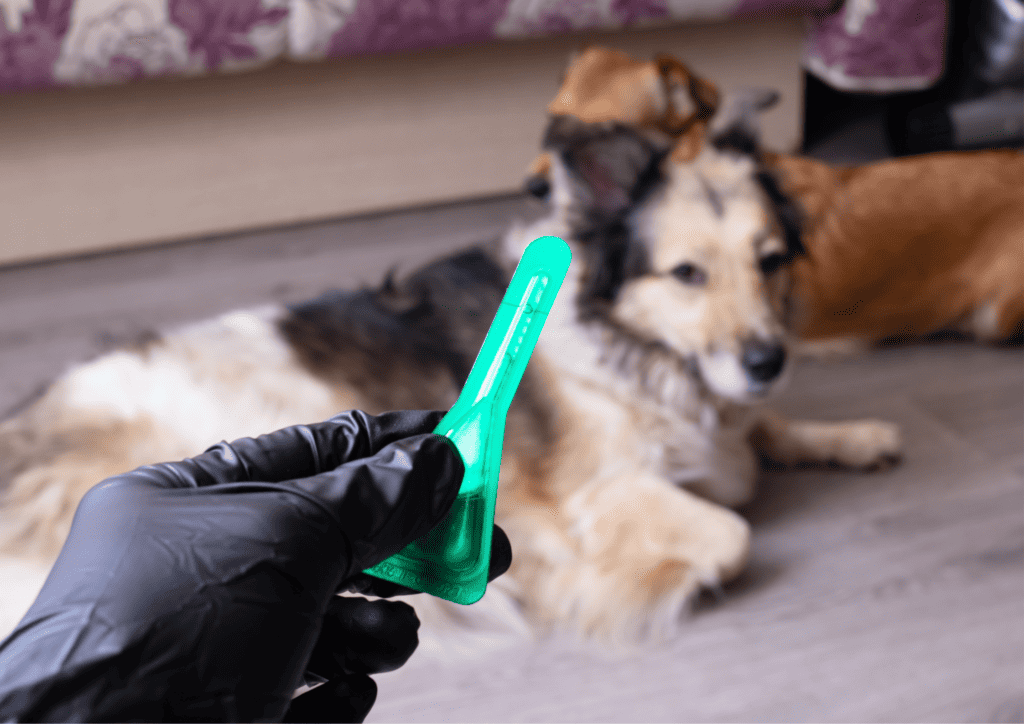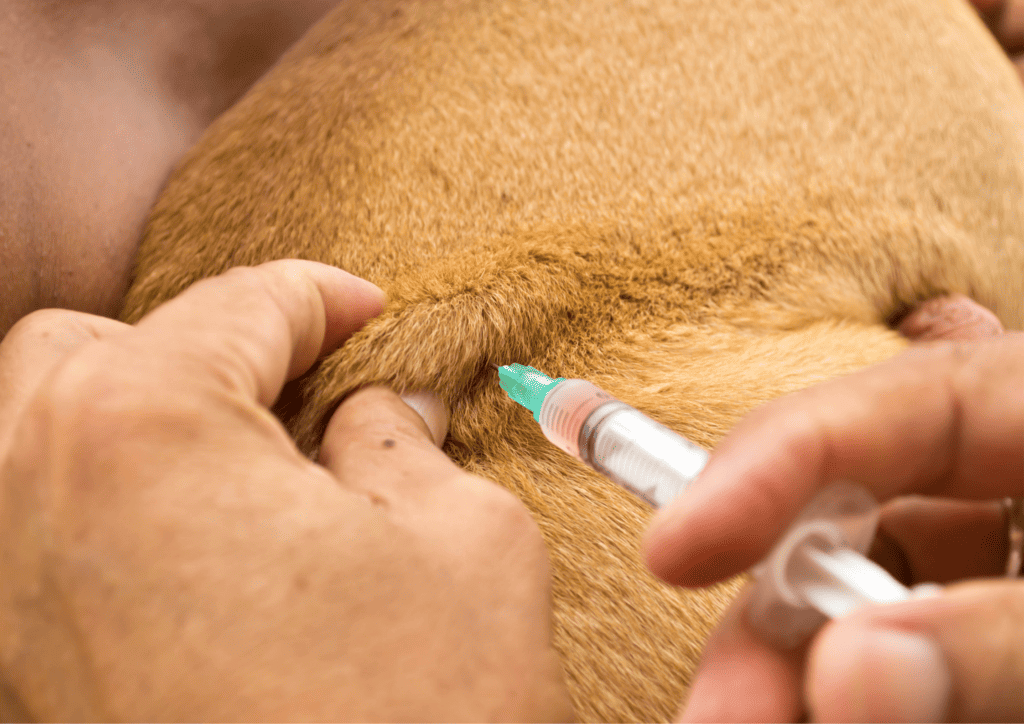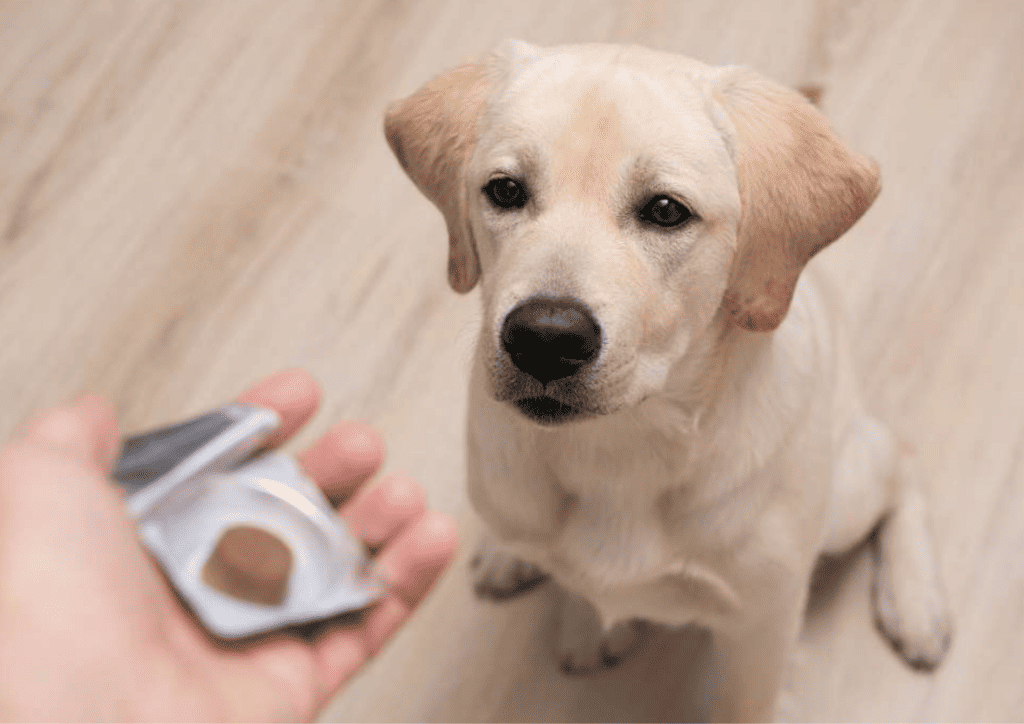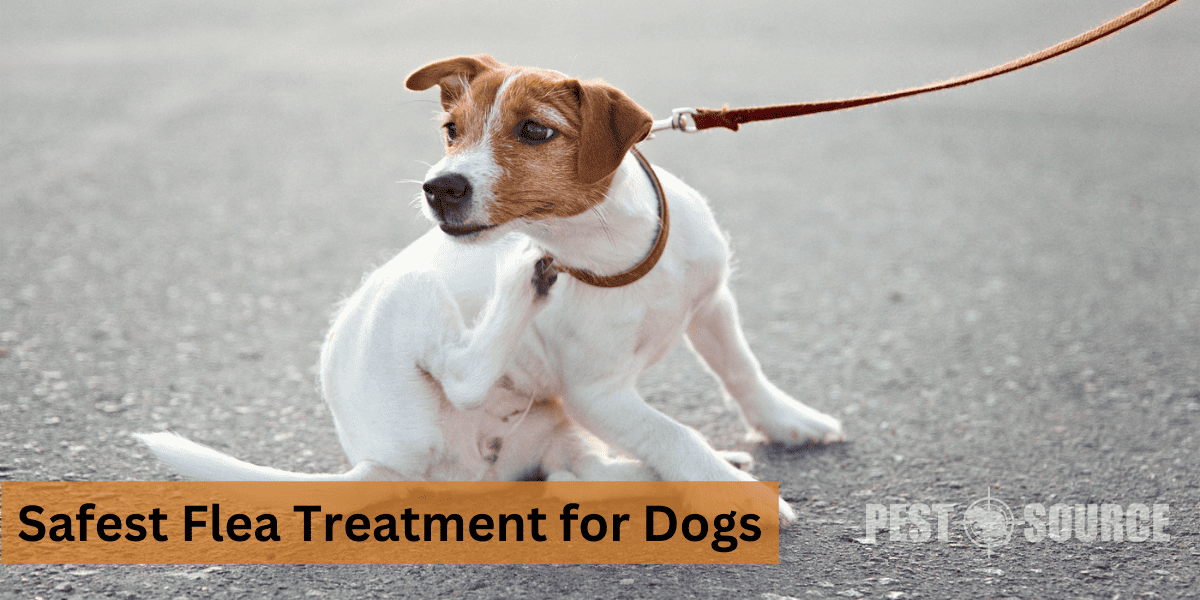Fleas are more than just a nuisance for our furry friends; they can lead to serious health issues if not treated properly. As dog owners, it’s crucial to understand the importance of safe flea treatment for dogs and ensure that we’re giving them the best care possible.
The safety of flea treatments is a concern for dog owners because some treatments may cause adverse reactions or side effects in dogs. In this article, we’ll discuss the safest flea treatments available for dogs, keeping in mind various factors such as the dog’s age, size, and specific health concerns.
POINTS
- Consult with your veterinarian before choosing and administering any flea treatment to ensure the safest and most appropriate option for your dog’s age, size, and health.
- Oral medications, topical treatments, and flea collars are commonly utilized safe flea and tick prevention methods, with each treatment type offering unique benefits and potential drawbacks.
- The safest flea treatment for puppies older than 12 weeks includes veterinary-approved topical treatments and flea collars designed specifically for their age and weight. Puppies under 12 weeks require a veterinarian consultation before using any flea treatment.
- Prescription flea treatments are usually more effective and targeted than non-prescription options, but non-prescription treatments can be more easily accessible and convenient for dog owners.
- Always carefully follow the label instructions when administering flea treatments, and monitor your dog for potential side effects or negative reactions, contacting your veterinarian if any concerns arise.
Understanding Flea and Tick Prevention Treatments
To better understand the variety of flea and tick prevention treatments available for dogs, it’s helpful to compare them side by side. Below is a table that outlines the main types of treatments, including their application method, effectiveness duration, and the pros and cons of each.
| Treatment Type | Method of Application | Duration of Effectiveness | Pros | Cons |
|---|---|---|---|---|
| Oral Medications | Ingested by the dog | 4-12 weeks | Easy to administer, systemic protection | Potential for gastrointestinal side effects |
| Topical Treatments | Applied to the dog’s skin | 1 month | Direct protection to treated areas | Can be messy, potential for skin irritation |
| Flea and Tick Collars | Worn around the neck | Up to 8 months | Long-lasting, low maintenance | Some dogs may experience allergic reactions |
| Flea Shampoos | Applied during bathing | Immediate (short-term) | Kills fleas on contact, immediate relief | No long-term protection, frequent use needed |
| Flea Dips | Diluted solution applied to fur | Immediate (short-term) | Intense treatment for severe infestations | Toxic chemicals, not for regular use |
What are the different types of flea and tick prevention treatments for dogs?
There are numerous ways to protect your dog against fleas and ticks. The main types of flea and tick prevention treatments include:
- Oral medications: Pills or chewables that are ingested by the dog to kill or prevent fleas and ticks.
- Topical treatments: Solutions that are applied directly to the dog’s skin, usually between the shoulder blades or at the base of the neck.
- Flea and tick collars: Worn around the dog’s neck to repel or kill fleas and ticks.
- Flea shampoos: Special shampoos designed to kill fleas upon contact.
- Flea dips: Concentrated solutions that are diluted with water and applied to the dog’s fur to kill fleas.
How do these treatments function in preventing fleas and ticks?
Each type of flea and tick prevention treatment works in a different way to keep your dog free from these pests:
- Oral medications: Often work by getting into the dog’s bloodstream, where fleas and ticks are exposed to the active ingredients.
- Topical treatments: Function by spreading across the dog’s skin and hair to create a protective barrier that kills or repels fleas and ticks.
- Flea and tick collars: Release chemicals that either repel or kill fleas and ticks in close proximity to the dog’s skin.
- Flea shampoos: Contain insecticides that kill fleas on contact during a bath.
- Flea dips: When applied to a dog’s fur, the solution kills fleas by penetrating their exoskeletons.
Safety of Flea Treatments for Specific Dog Populations
Selecting the appropriate flea treatment requires careful consideration of a dog’s specific needs, including their age, size, and health status. The table below provides a summary of recommended flea treatments for various dog populations, emphasizing safety considerations tailored to each group.
| Dog Population | Treatment Type | Age Considerations | Weight Considerations |
|---|---|---|---|
| Puppies | Topical treatments, Flea collars | Consult for under 12 weeks | Designed for their age and weight |
| Small Dogs | Topical treatments, Oral medications | N/A | Dosages based on body weight |
| Elderly Dogs | Oral medications, Topical treatments | N/A | Dosages adjusted for size |
| Senior Dogs | Topical solutions, Oral medications | N/A | Tailored to senior dog needs |
What is the safest flea treatment for puppies?
The safest flea treatment for puppies will vary depending on their age. For puppies under 12 weeks old, consult your veterinarian before using any flea treatment. They may recommend a gentle flea shampoo, combing with a flea comb, or a mild, non-chemical home remedy. Puppies over 12 weeks can usually be treated with topical treatments and flea collars designed specifically for their age and weight.
What is the safest flea treatment for small dogs?
Small dogs may be more sensitive to some flea treatments, which is why it’s vital to choose a product that is specifically designed for smaller breeds. Topical treatments made for small dogs or oral medications with dosages based on body weight are safer options. As always, consult your veterinarian to ensure the chosen flea treatment is appropriate for your small dog.
What is the safest flea medicine for elderly dogs?
Elderly dogs might have more fragile health conditions, making it crucial to select a flea treatment that poses lesser risk. Oral medications and topical treatments with specific dosages based on dog’s size are generally safer options for elderly dogs. Consult with your veterinarian to find the appropriate treatment option for your senior dog.
What is the safest flea treatment for senior dogs?
Like elderly dogs, senior dogs need special consideration when it comes to flea treatment options. In most cases, a topical solution or oral medication that is designed for use on senior dogs is the safest option. Make sure to consult with your veterinarian before starting any flea treatment on your senior dog to ensure the product you choose is appropriate and will not have any adverse side effects.
Understanding the Different Forms of Flea Treatments
What are flea collars, and are they safe for dogs?

Flea collars are a type of flea prevention method worn around a dog’s neck. They release chemicals that kill or repel fleas and ticks. Flea collars have been a popular option due to their low cost and convenience.
However, some flea collars may cause irritation, allergic reactions, or other negative side effects. In recent years, more advanced flea collars have been developed that release safer active ingredients (such as imidacloprid and flumethrin) that pose a lower risk to your dog. Consult with your veterinarian to determine if a flea collar is a safe and effective option for your dog.
What are flea drops, and how safe are they for dogs?

Flea drops, also known as spot-on or topical treatments, are solutions applied directly to a dog’s skin, usually between the shoulder blades or at the base of the neck. The active ingredients then spread across the skin and coat and kill or repel fleas and ticks.
Flea drops have generally proven safe for dogs when used according to label instructions and under a veterinarian’s guidance. However, some dogs may have a negative reaction to the chemicals, causing skin irritation or other side effects. Before using any flea drops, consult with your veterinarian to determine the best nature and dosage for your dog.
Are flea shots safe for dogs?

Flea shots, or injections, such as Program (lufenuron), are administered by a veterinarian and work by breaking the flea’s life cycle. The active ingredient in flea shots works to prevent flea eggs from hatching, preventing a full-blown infestation. These injections are not designed to kill adult fleas and are often used in conjunction with other flea control methods.
In general, flea shots are considered safe for dogs when administered by a veterinarian and used alongside other appropriate flea treatments. As with any medication, always discuss with your veterinarian the suitability of flea shots for your dog and any potential risks or side effects.
Comparison of Different Forms of Flea Treatments
What is the safest oral flea treatment for dogs? Are oral flea medications safe for dogs?

Oral flea treatments can be delivered in pill or chewable form and are ingested by the dog. Common oral treatments include nitenpyram, spinosad, and afoxolaner. These medications are generally safe for dogs when administered according to the prescribed dosage and under a veterinarian’s supervision.
However, side effects can occur, including vomiting, diarrhea, or neurological symptoms. Always consult your veterinarian to determine the safest oral flea medication for your dog, considering their age, size, and health.
What is the safest topical flea treatment for dogs? Is topical flea treatment safer than oral?

Topical flea treatments, or spot-ons, are drop-like solutions applied directly to the skin. These treatments can be effective at killing or repelling fleas and ticks. Whether a topical treatment is safer than oral medication depends on several factors, such as the dog’s size, age, and specific health concerns.
Some dogs may experience skin irritation or other side effects from topical treatments. Conversely, some dogs may have gastrointestinal issues or different side effects from oral medications. Consult your veterinarian to determine which flea treatment is the safest and most effective for your dog.
What is the safest flea and tick collar for dogs?
When it comes to flea and tick collars, the safest one for your dog is often a veterinarian-recommended product. Collars containing slow-release insecticides, such as those with imidacloprid and flumethrin, tend to be safer for dogs due to their lower concentration of toxins.
Always consult your veterinarian before using a new flea and tick collar to determine which product will work best for your dog and ensure they don’t experience adverse side effects.
Can I give my dog oral and topical flea treatment at the same time?
Using multiple flea treatments simultaneously can be risky, as giving too much medication increases the chance of side effects. Before using any combination of flea treatments, discuss with your veterinarian the best approach for your dog’s specific needs.
What’s the most effective flea treatment for dogs?
The most effective flea treatment for your dog depends on factors such as their size, age, health, and any environmental factors or other pets in the home. To determine the best treatment for your dog, consult with your veterinarian and consider product efficiency, safety, and your dog’s overall well-being.
Concerns about Flea Treatments and their Side Effects
While flea treatments are essential for keeping your dog pest-free, it’s important to be aware of potential side effects that can occur. The table below outlines common side effects associated with different types of flea treatments, providing insights into their incidence rates and preventative measures.
| Treatment Type | Common Side Effects | Incidence Rate | Preventative Measures |
|---|---|---|---|
| Oral Medications | Vomiting, diarrhea, lethargy | Low to Medium | Administer with food, monitor after first dose |
| Topical Treatments | Skin irritation, redness, excessive scratching | Medium | Test on small area first, avoid over-application |
| Flea Collars | Allergic reactions, skin irritation under collar | Low to Medium | Regularly check fit and skin condition, adjust as necessary |
| Flea Shampoos | Dry skin, irritation, allergic reactions | Medium | Use sparingly, choose mild formulas |
| Flea Dips | Chemical burns, respiratory issues | Medium to High | Use in well-ventilated areas, follow instructions carefully |
Are flea and tick pills safe for dogs? Are chewable flea and tick treatments safe?
Oral flea and tick treatments, including pills and chewables, are generally safe for use in dogs as long as they are administered according to the package instructions and under a veterinarian’s supervision. However, some dogs may experience side effects such as gastrointestinal issues or neurological symptoms. It is essential to consult your veterinarian to determine the safest and most suitable oral flea treatment for your dog.
What flea and tick medicine is known to cause seizures in dogs?
Some oral flea and tick medications belonging to the Isoxazoline class, including fluralaner (Bravecto), afoxolaner (NexGard), and sarolaner (Simparica), have been linked with a potential risk of causing seizures or other neurological symptoms in dogs. While these medications are generally considered safe for most dogs, they may not be recommended for dogs with a history of seizures or neurological disorders. Always consult your veterinarian before starting any flea and tick medication, especially if your dog has a history of seizures.
What are safe flea and tick prevention methods for dogs with seizures?
For dogs with a history of seizures or neurological issues, it might be safer to opt for topical treatments or flea collars, as these generally pose a lower risk of inducing seizures. However, it is crucial to consult with your veterinarian to determine which treatment is most appropriate for your dog’s specific needs.
What flea treatment is safe for dogs that does not cause seizures?
Choosing a flea treatment that is unlikely to cause seizures usually involves avoiding medications from the Isoxazoline class. Flea treatments with different active ingredients, such as topical solutions or flea collars, can be safer alternatives. Before opting for any flea treatment for your dog, consult your veterinarian to ensure the treatment is safe and suitable for your pet.
Evaluating the Safety of Flea Medications
What is the safest flea medication for dogs?
The safest flea medication for dogs depends on the individual dog’s size, age, and health concerns. Commonly utilized safe treatments include topical solutions, oral medications, and flea collars. Consult your veterinarian to determine which treatment is the most appropriate and safe option for your dog.
What is the safest flea and tick medicine for dogs?
No single flea and tick medication is universally the safest for all dogs. Veterinarians often recommend topical treatments, oral medications, or flea collars based on the dog’s specific needs and health background. Consulting your veterinarian is the best way to ensure you are choosing the safest flea and tick treatment for your dog.
Alternatives to Common Flea and Tick Treatments
What is the least toxic flea treatment for dogs?
Natural or non-chemical flea treatments for dogs can be an alternative to traditional flea medication and are often considered less toxic. These can include flea combs, diatomaceous earth, or essential oil-based flea sprays. However, it is important to remember that alternative treatments may not be as effective as traditional methods. Consult with your veterinarian to find a suitable and effective non-toxic flea treatment for your dog.
What are non-toxic flea treatments for dogs?

Non-toxic flea treatments for dogs can include:
- Flea combs to manually remove fleas and their eggs from your dog’s fur.
- Diatomaceous earth, a natural powder that dehydrates and kills fleas.
- Essential oil-based flea sprays containing substances like lemongrass or eucalyptus, which naturally repel fleas.
It’s essential to consult with your veterinarian before using any non-toxic flea treatments, as they may be less effective than traditional treatments and could pose some risks to your dog’s health.
What is the best non-toxic flea treatment for dogs?
There is no universal-answer for the best non-toxic flea treatment for dogs, as the effectiveness and safety of these treatments will vary depending on the individual dog and their specific needs. Always consult with your veterinarian before trying any non-toxic flea treatments to determine the safest and most effective option for your dog.
Prescription vs Non-Prescription Flea Treatments
What is the best flea treatment for dogs without a vet prescription?
Non-prescription flea treatments, such as over-the-counter topical treatments and flea collars, can be effective in controlling fleas on your dog. However, their effectiveness and safety may vary compared to prescription flea treatments. Always consult with your veterinarian before using any over-the-counter flea treatment to ensure it’s the most suitable option for your dog.
What prescription flea treatments are available for dogs?

Prescription flea treatments for dogs can include various oral medications, such as spinosad (Comfortis), afoxolaner (NexGard), and fluralaner (Bravecto), as well as topical treatments like selamectin (Revolution) or fipronil-methoprene (Frontline Plus). It’s essential to visit your veterinarian for a consultation, as a prescription flea treatment will depend on your dog’s age, size, health, and specific needs.
What are the benefits and drawbacks of prescription vs non-prescription flea treatments for dogs?
The benefits of prescription flea treatments include their higher efficacy in treating and preventing flea infestations, as well as support from your veterinarian in selecting and administering the appropriate treatment. Prescription treatments may also be more targeted and have fewer side effects compared to non-prescription options.
On the other hand, one of the main benefits of non-prescription flea treatments is their ease of access, as they can often be purchased from pet stores or online without requiring a veterinary consultation. However, non-prescription treatments may be less effective, and without specific guidance from your veterinarian, there is a higher risk of improper use or incorrect dosage.
Preventative Measures and Considerations for Flea and Tick Infestations
What is the safest flea and tick prevention for puppies?
For puppies under 12 weeks old, consult your veterinarian before using any flea treatments. After 12 weeks, veterinary-approved topical treatments and flea collars specifically designed for puppies can be considered safe. The safest flea and tick prevention method for your puppy will depend on factors such as their age, size, and overall health.
How long does each flea treatment usually last?
The duration of a flea treatment varies depending on the method used:
- Oral medications: Typically last between 4-12 weeks, depending on the specific active ingredient.
- Topical treatments: Usually last for approximately one month.
- Flea collars: Offer protection for up to 8 months, depending on the brand and active ingredients.
It’s essential to consult the label and follow instructions on the frequency of reapplication and consult your veterinarian to ensure ongoing protection for your dog.
Are flea collars or drops more effective in preventing fleas and ticks in dogs?
There is no definitive answer, as the effectiveness of flea collars vs. drops largely depends on the dog and the specific product being used. Some flea collars are highly effective in preventing fleas and ticks, while others fall short. Similarly, some topical treatments work better for certain dogs than others. The most effective treatment will depend on your dog’s unique needs, which is why it’s essential to consult with your veterinarian to determine the best treatment option.
How do you safely administer flea treatments to dogs?
Administering flea treatments safely is crucial to protect your dog’s health while effectively controlling pests. The following table offers guidance on the proper application of various flea treatments, including dosage instructions and safety tips to minimize the risk of adverse reactions.
| Treatment Type | Dosage Instructions | Safety Tips | Signs of Negative Reaction |
|---|---|---|---|
| Oral Medications | Follow vet’s prescription or label for weight-specific dosage | Ensure dog swallows medication; watch for digestive upset | Vomiting, diarrhea, lethargy |
| Topical Treatments | Apply directly to the skin, between shoulder blades or at base of neck | Avoid contact with eyes/mouth; let dry before petting | Skin irritation, redness, excessive scratching |
| Flea Collars | Adjust for a snug fit, allowing room for two fingers under the collar | Check regularly for skin irritation; replace as directed | Redness, hair loss, scratching at collar area |
| Flea Shampoos | Use during bath as directed on label, avoiding eyes and mouth | Rinse thoroughly to prevent residue; monitor for skin dryness | Dry skin, irritation, allergic reactions |
| Flea Dips | Dilute according to instructions; apply without rinsing off | Use in well-ventilated area; protective gloves recommended | Chemical burns, skin irritation, respiratory issues |
Always observe your dog after treatment for any signs of discomfort or adverse reactions, and consult a veterinarian if you have concerns.
Conclusion: Choosing the Safest and Most Effective Flea Treatment
To ensure the safest and most effective flea treatment for your dog, consult with your veterinarian to discuss the available options based on your dog’s size, breed, age, and health. By taking the time to research and consult with a professional, you increase the chances of preventing flea and tick infestations successfully and keeping your furry friend healthy and happy. Remember the key takeaways about safe flea treatments for dogs: seek advice from your veterinarian, choose the appropriate treatment for your dog, and carefully follow all instructions to ensure your dog remains flea-free and healthy.



